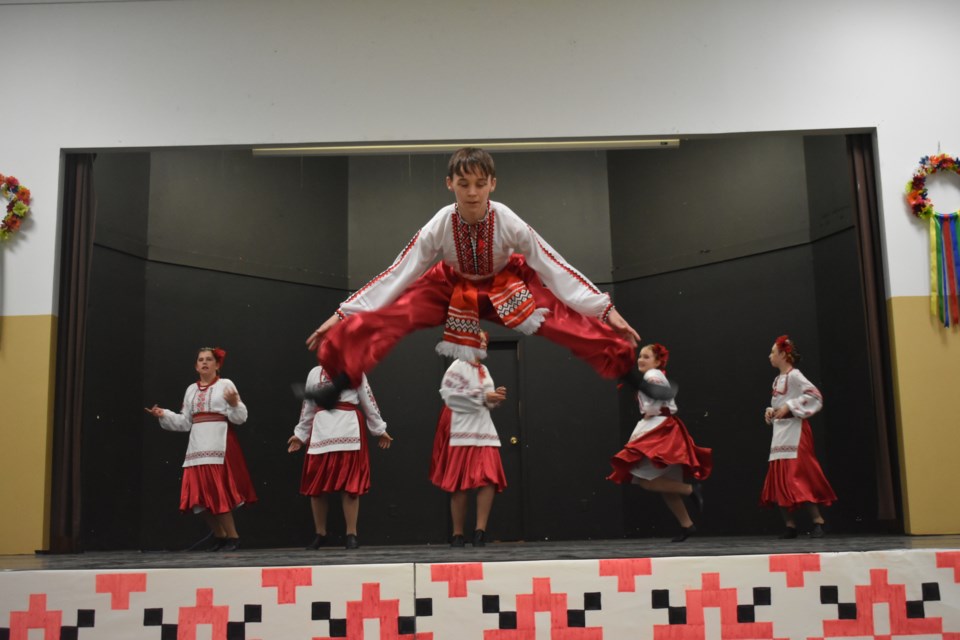NORQUAY- The Norquay Rosa Ukrainian Dance Club hosted its annual Spring Concert on the 6th of May at the community hall. Thomas Hazlett served as the master of ceremonies for the event, which opened with the Canadian and Ukrainian national anthems. The adult dance group then presented the Bread and Salt with Brylee Chermcora and Jake Holinaty. Bread and salt are a significant part of Ukrainian culture, symbolizing hospitality and eternal friendship, respectively.
The evening's highlight was the presentation of senior dancer Lily Kish, who has been dancing with the Rosa Dance Club for 10 years. Kish was honoured with a Ukrainian crown called "vinok" to mark the occasion, which is worn by young women to symbolize purity and fertility, and is an integral part of the traditional folk dress. “Its ingredients range from flowers, feathers, hemp threads, shells, and beads, to even pieces of foil, wax, and painted sawdust for sparkles. The Ukrainian flower crown is still used widely today to honour past traditions and is known as a symbol of national pride,” said Thomas Hazlett. After this ceremony, Lily Kish performed a solo Poltava dance.
The concert featured dances from different regions of Ukraine, including Poltava, Hutzul, Volyn, Bukovina, and the Transcarpathian region of Ukraine, which were met with enthusiastic applause from the audience.
Poltava is known for housing the most popular form of Ukrainian dance according to Hazlett, the dance is characterized by its lively and energetic movements, with dancers leaping and twirling to the rhythm of traditional Ukrainian music. The dancers wore colourful costumes, with the girls' dresses featuring floral patterns and the boys' attire consisting of embroidered shirts and pants.
Hutzul is a mountainous region in western Ukraine where dancers traditionally wear leather moccasins known as “postoly” and decorated vests known as “keptari.” Women wear a skirt composed of front and back panels tied at the waist. Hutzul costumes traditionally incorporate orange, brown, green, and yellow embroidery.
Located in northwestern Ukraine you will find the Volyn region. Dancers from this region wore costumes that were bright and vibrant, with dance steps full of energetic jumping, high legs, and lively arm movements.
Lily Kish, as a senior solo dancer, performed representing the Transcarpathian region of Ukraine. Dances from this region are known for their large sweeping movements and colourful costumes, with the general movement being described as "bouncy."
The Group 6 dancers performed representing Bukovina, a transitional highland between Ukraine and Romania. In these dances, both men and women perform a variety of foot stamps.
The event also had a guest dancer, Maddy Storrey performing her lyrical solo, Lost Without You. In competition, she has received two first place awards( ruby and gold) in Weyburn, a second place outstanding lyrical solo award (diamond) in Regina and a first place level-up special award (gold with honours) in Yorkton.
During the adult dancers' Poltava performance, the dancers found that one of them was pregnant. The dance eventually spiralled into a fictional hospital visit with a wheelchair and scrubs included among the dancers. The pregnant dancer then proceeded to birth a rather large baby, a Ukrainian dancer wearing a bonnet. The unexpected nature of this performance greatly amused the audience for its comedic nature.
Group 2, comprising first and second-graders, won a Gold medal at a dance competition this year for their Poltava dance, displaying their dedication and hard work. Group 3, who performed a Hutsul dance, and Group 4, who presented a Volyn dance, brought home silver medals. Group 5, the oldest dancers, performed a Poltava dance, and the pre-kindergarten Group 1 showed off the basic steps of the Poltava region, displaying their potential and promise.
The concert ended with the Kolomeyka. This performance gave the dancers a chance to perform their favourite steps in a large circle.
The concert was a celebration of Ukrainian culture, heritage and spring. It was clear that the Norquay Rosa Ukrainian Dance Club's annual Spring Concert continues to be a highlight of the community's calendar and a significant cultural event. The dedication, hard work, and passion of the club members and dancers were evident, leaving a lasting impression on those in attendance.




